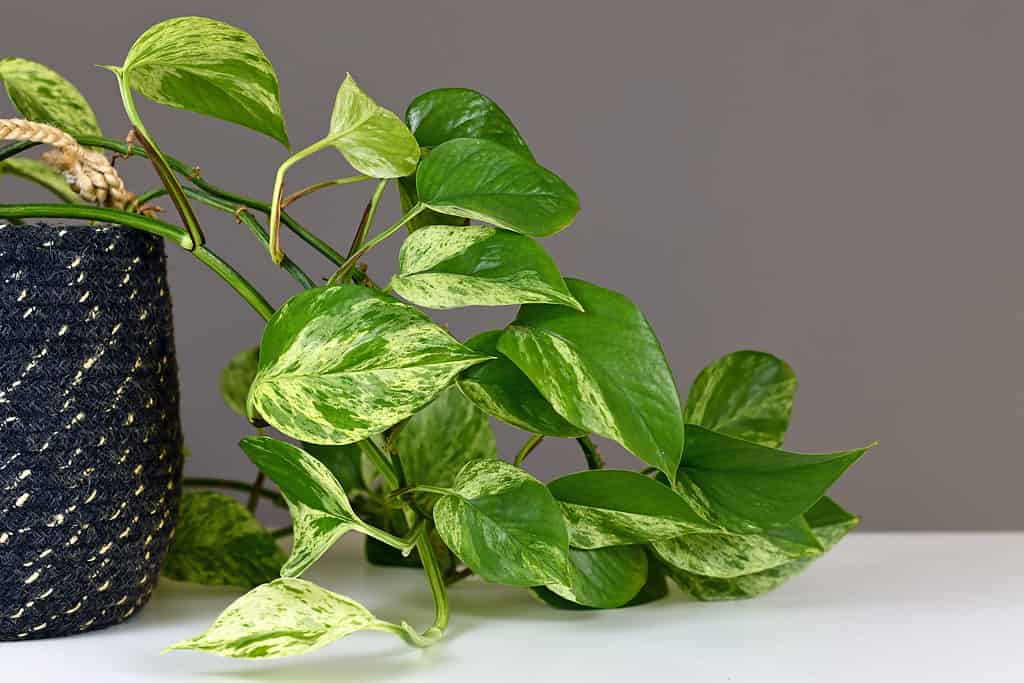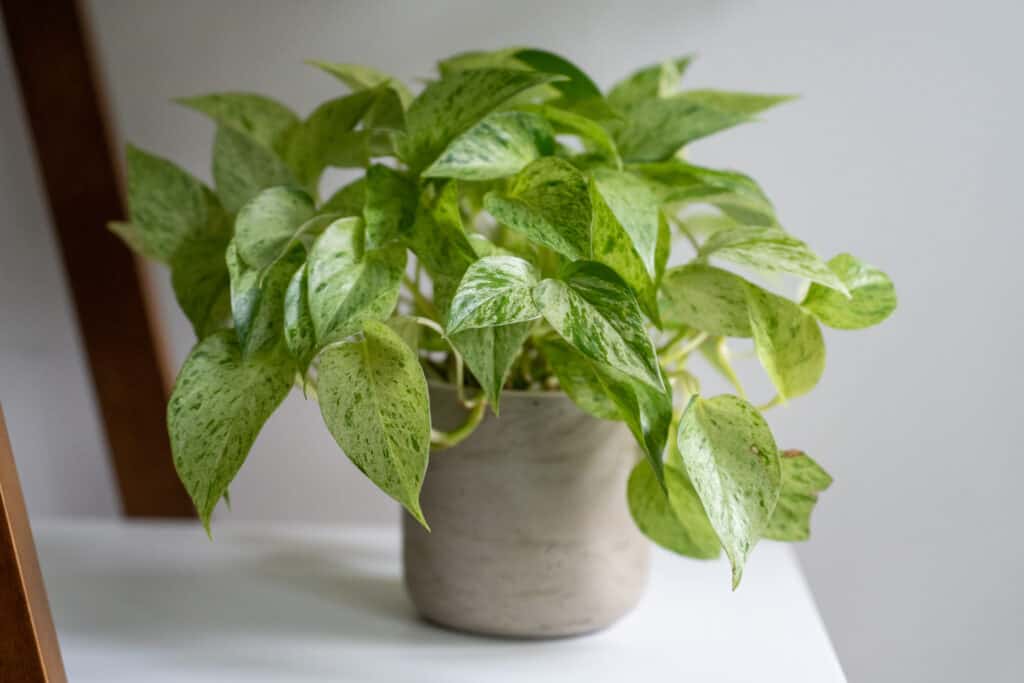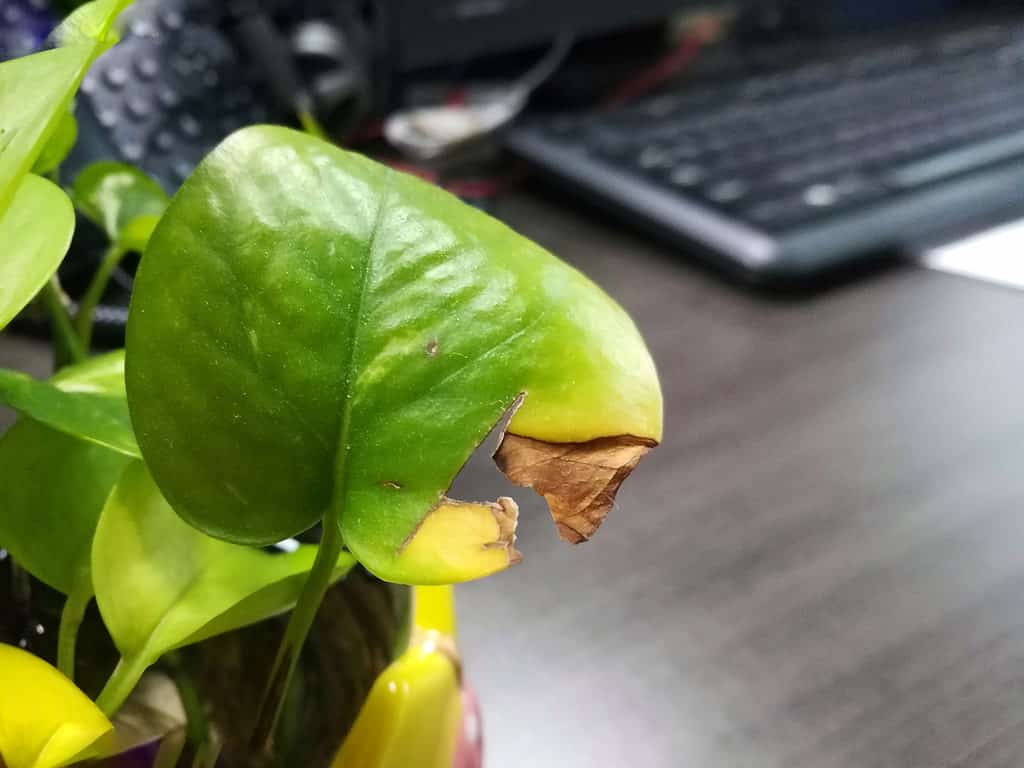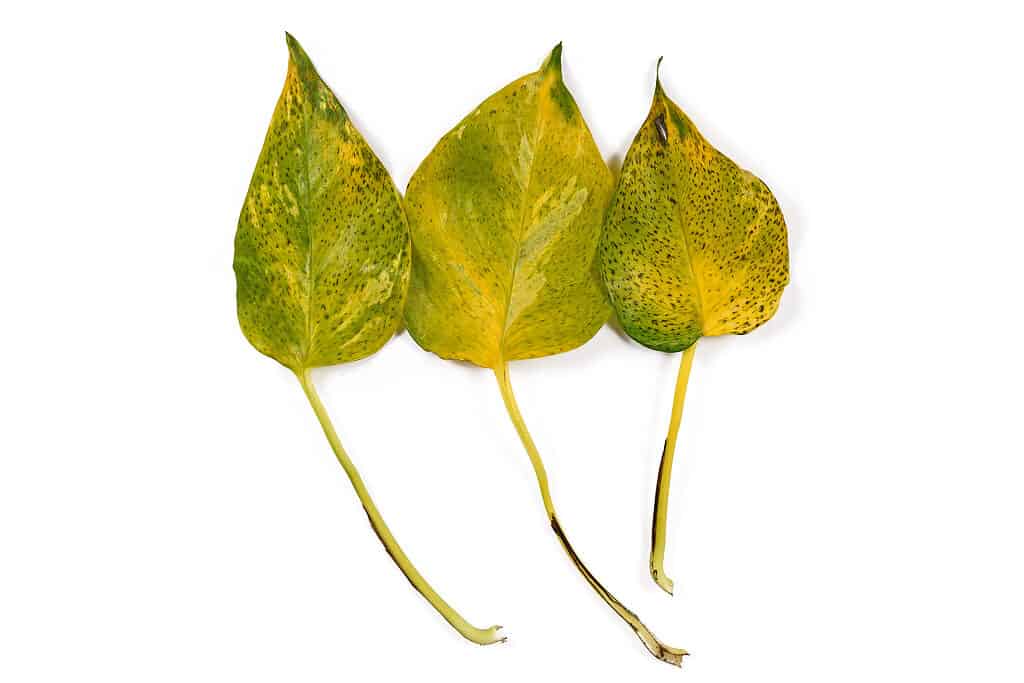If you’re caring for a pothos plant, you may at some point run into an issue with the leaves turning yellow. Thankfully, this plant is known for its resilient nature, and with the right know-how, you should be able to remedy the problem!
In this guide, we’ll cover what pothos needs to thrive, the main reasons why pothos leaves turn yellow, and how to fix it.
So, without further ado, let’s jump in!
Pothos: Plant Classification and Introduction
A member of the Arum (Araceae) family, pothos is a lovely climbing vine that first originated in the Solomon Islands of the South Pacific. From there, pothos (Epipremnum aureum) has become a beloved houseplant the world over. Commonly called devil’s ivy for its nearly unkillable nature, this plant is fantastic for beginner houseplant lovers.
If you want to dive into the world of caring for houseplants, but are nervous about keeping them alive, pothos is an excellent choice. Now, that’s not to say that pothos is unkillable or that it can’t suffer from lack of care. This plant still needs its basic growing requirements met to thrive. So, below, we’ll talk about what those requirements are and how you can best care for this lovely plant.

Pothos is a lovely climbing vine that first originated in the Solomon Islands of the South Pacific.
©iStock.com/Firn
Caring for Pothos
If you’re having trouble with pothos leaves turning yellow, you’ll want to first make sure that you understand what this tropical vine needs to thrive. That way, you can determine if there’s a hole in this plant’s care that is contributing to its yellowing leaves. So, to live its best life, pothos needs the following:
- Medium-to-bright indirect sunlight. As a plant that naturally grows in the understory of larger tropical trees, this plant suffers from exposure to direct sunlight. Instead, it needs at least 8 hours a day of indirect sunlight or an applicable amount of artificial lighting.
- Slightly acidic (6.0-6.5 pH), well-draining, fertile, and well-aerated soil. Pothos can handle a bit of a drought, but it does not like getting its roots wet. If you’re going to focus on just one aspect of the soil or potting medium for this plant, make sure it’s well-draining!
- To be thoroughly watered about once a week when the top 2-3 inches of the soil is entirely dry. Remember, too much water can really negatively affect this plant. It does like the soil moist, just not saturated. If only the top 2-3 inches are dry, the center of the soil should still be nice and moist.
- Humidity of 50-70%. This tropical plant loves humidity. If your home’s air is drier than its ideal moisture range, you can add a humidifier a few feet away from the plant to raise the humidity of its immediate environment.
- Temperature of 70-90 degrees Fahrenheit. While this heat-loving plant can typically survive down to 55 degrees Fahrenheit, it won’t thrive at these temps.
- A pot with a drainage hole that is about 2 inches wider than the diameter of the root ball.

While pothos plants are very easy to grow they need indirect sunlight, proper soil and modest watering to thrive.
©iStock.com/Jenny Sun
Pothos Leaves Turning Yellow: 5 Main Reasons Why
So, now that you know what pothos needs to thrive, we can cover the main reasons why this plant’s leaves are turning yellow. First, it’s important to note that pothos leaves can turn yellow naturally as the plant ages. If you’re seeing healthy, new growth on the plant with some yellowing of mature leaves at the base of the plant, that’s likely just healthy aging. These old leaves will eventually be shed as new growth emerges. However, if the plant is developing yellowing on younger leaves and is drooping or has other alarming signs, then it’s likely a problem that needs to be quickly resolved. The following are the most common problematic causes of pothos leaves turning yellow:
- Overwatering.
- Underwatering.
- Exposure to direct sunlight.
- Lack of nutrients in the soil.
- Disease.
Pothos Leaves Turning Yellow: Overwatering
Perhaps the most common problematic reason why pothos leaves turn yellow is due to overwatering. It’s especially easy to overwater potted plants, and pothos really does not appreciate soggy roots. If you’re overwatering this plant, one of the first signs you will see is droopy, yellowing leaves. Now, these leaves will present as limp and almost translucent and may have some brown spotting. They shouldn’t be crispy or especially dry to the touch.
If you suspect overwatering is your problem, check the soil. You can check the moisture content of the soil with your finger or with a moisture meter. If the top 2-3 inches of the soil never seem to fully dry out and your plant is displaying the abovementioned signs, it’s highly likely that your pothos is suffering from too much watering.
How to Fix
If the yellowing and drooping aren’t too widespread or severe, you can give the plant a break from watering and make absolutely certain that you only water when the top couple inches of the soil is entirely dry. Make sure the pot has a drainage hole as well. Additionally, you’ll want to be sure that the pot isn’t too big for the plant. If the pot is too big for your pothos, what happens is that when you water it the excess soil retains the moisture that the roots can’t take up and the plant becomes susceptible to soggy roots. Remember, the pot should only be about 2 inches wider than the diameter of the root ball.
Now, if your pothos plant has widespread yellowing and drooping, you may need to gently remove it from its pot to replant it in dry soil. We’ll explain further below what to do if you see signs of root rot in the process of removing the plant.
Pothos Leaves Turning Yellow: Underwatering
While overwatering pothos is more likely to cause yellowing leaves faster than underwatering, you still need to make sure this plant receives enough moisture to thrive. If you’re underwatering your pothos plant, you’ll likely see yellowing and drooping leaves, but the leaves will be crispy around the edges. You’ll likely also see brown, crispy spots. If you suspect that your plant is suffering from underwatering, check the soil. If the soil deeper than 2-3 inches is entirely, then underwatering is likely your culprit. With underwatering, you’ll also often see soil pulling away from the edges of the pot as the roots try to uptake any moisture available in the pot.
How to Fix
To fix this issue, you’ll want to allow your plant to deeply drink up. Rather than watering from above, with an underwatered plant it’s a better idea to place the pot in a pan of water and allow the roots to deeply uptake as much water as it needs for the next 24 hours. Once you allow the plant to be thoroughly watered, make sure to water it about once a week when only the top 2-3 inches of the soil is dry.
Pothos Leaves Turning Yellow: Exposure to Direct Sunlight
Some people may mistakenly think this tropical, heat-loving plant would enjoy basking in direct sunlight. But, remember, this plant naturally grows in the understory of its tropical habitat, and as such, receives filtered sunlight through the canopy of the jungle trees. So, it’s crucial to place this plant in a location where it isn’t exposed to direct sunlight. If you think your pothos leaves are turning yellow due to direct sunlight exposure, you’ll likely notice burnt, crispy, yellow-brown spots on the leaves.

Burnt, crispy, yellow-brown spots on pothos leaves can indicate that your plant is getting too much direct sunlight.
©ukmng/Shutterstock.com
How to Fix
To remedy this problem, you’ll want to move your pothos into a more suitable location. If more than half of the leaf is crispy and burnt, cut the leaf off with clean snips just above the node of the stem. Suitable locations for pothos include North, East, and West-facing windows and other locations in the house that receive filtered light or adequate artificial lighting.
Pothos Leaves Turning Yellow: Lack of Nutrients in the Soil
When you grow plants in pots, the nutrients in the soil become depleted over time, and unlike the soil outside, there is no inherent microbial community to break down organic matter and replenish nutrients. If the soil your pothos is growing in is nutrient-depleted you will often see yellowing of the leaves along with stunted growth. New growth may also emerge yellow with nutrient depletion.
How to Fix
Since pothos grows quite quickly, it’s important to replenish the nutrients in the soil about once every 6 weeks during its spring and summer growing seasons. You can replenish these nutrients by adding suitable organic compost or a balanced NPK (Nitrogen-Phosphorus-Potassium) liquid fertilizer. It’s also a great idea to repot your pothos once a year to both give it more room as the plant grows and to replant it in fresh soil packed with nutrients.
Pothos Leaves Turning Yellow: Disease
The last final most common problematic reason for pothos leaves turning yellow is disease. When pothos isn’t growing in optimal conditions, it can become more susceptible to infection. One common disease seen with pothos that includes yellowing of the leaves is root rot.
Root rot occurs from overwatering. As the plant’s roots sit in soggy soil, it becomes the perfect breeding ground for fungal or bacterial pathogens that love soggy, anaerobic environments. As root rot sets in, you’ll see a thick, slimy film covering the roots of the plant and you’ll also likely notice a sour, egg-like smell coming from the base of the plant. It’s crucial to effectively address this disease in a timely manner as root rot can quickly kill your plant.

Yellowing pothos leaves can be a sign of disease.
©Firn/Shutterstock.com
How to Fix
If you have confirmed your plant is being overwatered, and you’re worried about root rot, you’ll need to remove the plant from the soil, clean the infected areas, and replant your pothos into clean soil. You’ll want to make sure to not handle other plants during this process to avoid spreading the pathogen. To treat root rot in pothos, follow the below steps:
- Prepare a new pot with a fresh, clean growing medium.
- Gently remove pothos from the infected soil.
- Using sterile snips, cut off any sections of roots or stems that are covered in the film and clearly rotting. As you work, continuously dip your pruners in a solution of 1 part disinfectant to 3 parts water to keep the snips clean and prevent the spread of disease to the unaffected roots.
- Gently wash the roots to remove any remaining film.
- Treat the remaining roots with an appropriate fungicide.
- Replant your pothos into a fresh pot with clean soil and make sure to keep to an adequate watering schedule.
Up Next
- Pothos Leaves Turning Brown: Why It’s Happening and How to Fix
- Are Pothos Plants Toxic to Dogs or Cats?
- Do Pothos Plants Produce Flowers?
The photo featured at the top of this post is © Shadow Inspiration/Shutterstock.com
Thank you for reading! Have some feedback for us? Contact the AZ Animals editorial team.







